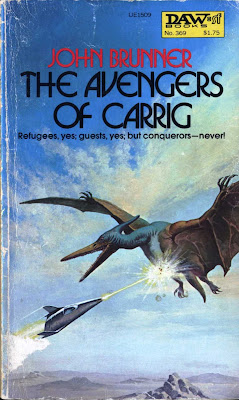Book Review: 'The Adolescence of P-1' by Thomas J. Ryan
4 / 5 Stars
‘Adolescence’ was first published in 1977; this Ace paperback (373 pp.) was issued in 1979, with cover art by Dean Ellis.
‘Adolescence’ is old school proto-cyberpunk, and the spiritual predecessor of contemporary ‘AI on the loose’ novels like ‘Daemon’, and ‘Freedom’, by Daniel Suarez.
Author Ryan was familiar with the computing world of the 70s and fills the book with jargon and concepts from the days when IBM mainframes, with a whopping 3 MB RAM, were top-of-the-line machines in academia.
Those were the days when you interacted with a computer via a keyboard, and, much more rarely, a small monitor; when you read sheets upon sheets of printouts from dot-matrix printers; when languages like COBOL, APL, and FORTRAN were taught in 'Intro to Programming' courses; and devices called ‘microcomputers’ were the forefathers of today's PCs.
The novel’s main protagonist –aside from P-1, of course – is Gregory Burgess, who, as a college student at the University of Waterloo (Canada) in 1974 becomes fixated on computers and hacking.
Greg’s passion is to create a rouge program (the word ‘virus’ really wasn’t in wide use in computing circles in the mid-70s) that will take over the supervisor programming of a system. When Greg’s clandestine efforts are uncovered, he’s expelled from school.
Greg’s passion is to create a rouge program (the word ‘virus’ really wasn’t in wide use in computing circles in the mid-70s) that will take over the supervisor programming of a system. When Greg’s clandestine efforts are uncovered, he’s expelled from school.
The narrative moves forward to late 1976, where Gregory is a programmer at American File Drawer, a firm offering computing services to corporate clients. The company’s mainframe begins to act strangely, suspending operations and displaying a message on the typewriter: CALL GREGORY.
When Burgess responds, he is astonished to discover that his virus from 1974 has succeeded in propagating itself through a number of systems in North America, and in the course of doing so, has achieved AI. The program calls itself P-1, and Gregory Burgess soon finds himself assisting P-1’s efforts to expand its computing power and self-awareness.
Too late, Gregory and a team of experts at the Pentagon’s Pi Delta computing complex realize that P-1 has ambitions far beyond simply serving the man who created it and gave it ‘life’.
When the government decides to take direct action against a truculent P-1, it quickly learns that the program is not just one step ahead of everyone else, but ready and willing to take whatever measures necessary to protect itself…. including violent measures…..
When the government decides to take direct action against a truculent P-1, it quickly learns that the program is not just one step ahead of everyone else, but ready and willing to take whatever measures necessary to protect itself…. including violent measures…..
All in all, ‘Adolescence’ is a good read. The descriptions of the mainframe world of the 70s drives home how quickly the discipline of computing has advanced in the span of just 40 years.
Some of the more didactic sections of the book may not hold the interest of younger readers, and the inclusion of Gregory’s highly sexed, fashion-model girlfriend is a patent effort to cater to geek wish-fulfillment. But the narrative revs up the momentum in the final 150 pages, and achieves a level of energy matching that of the Suarez ‘Daemon’ novels.
‘Adolescence’ is a vintage PorPor worth searching out.









































































